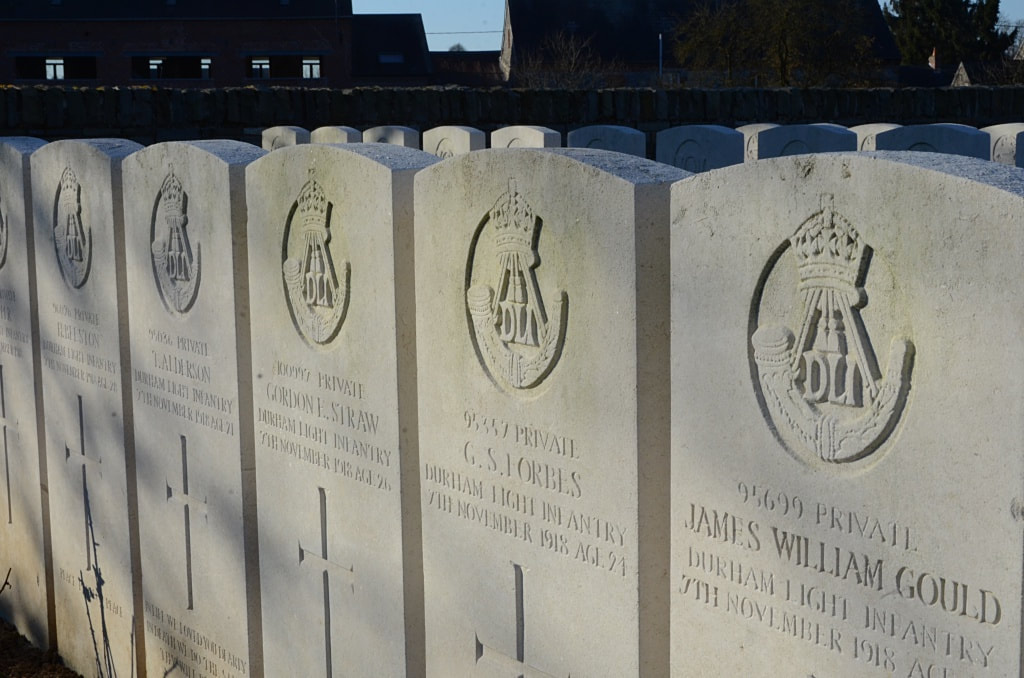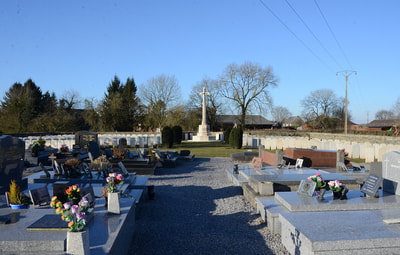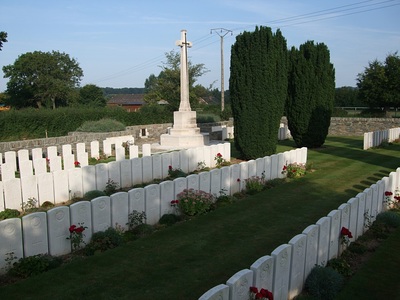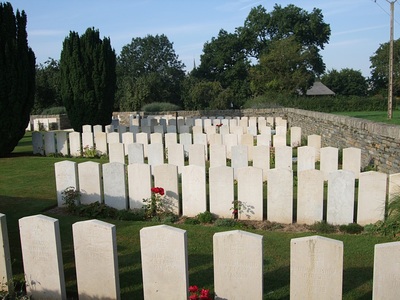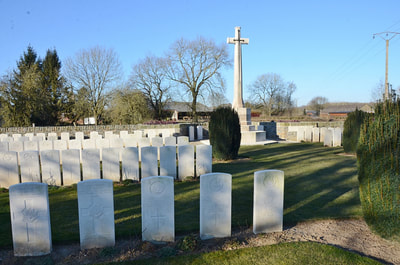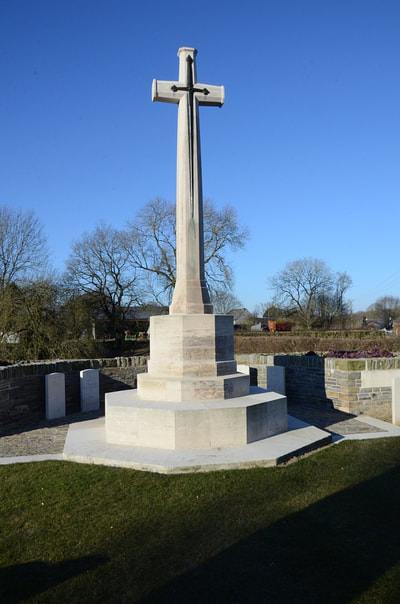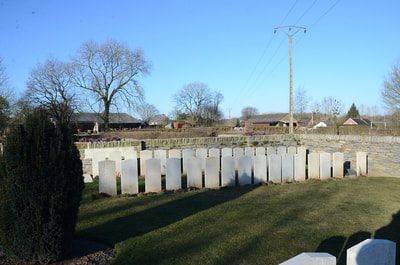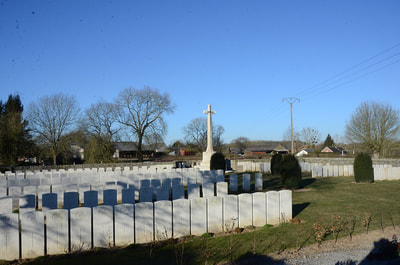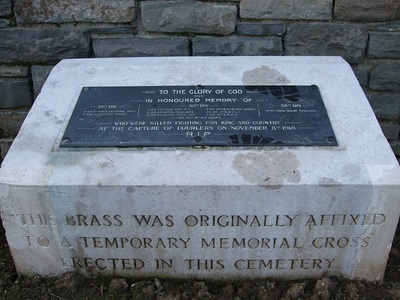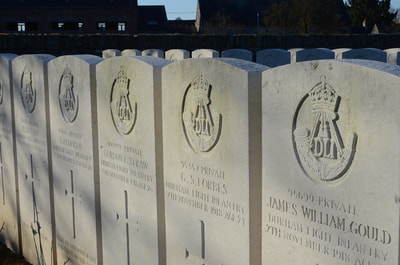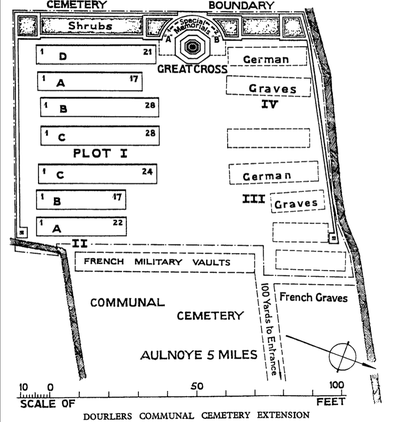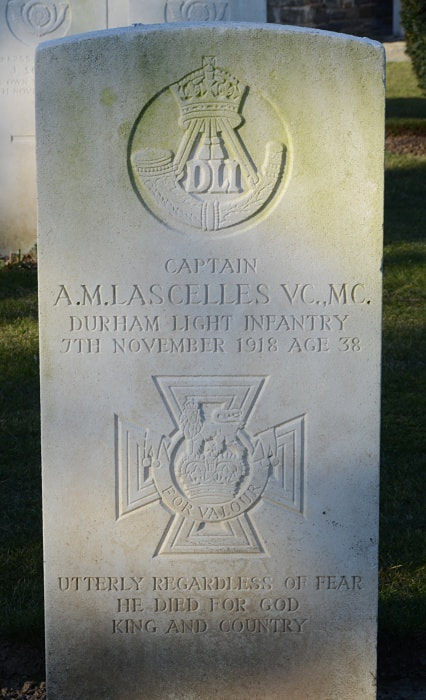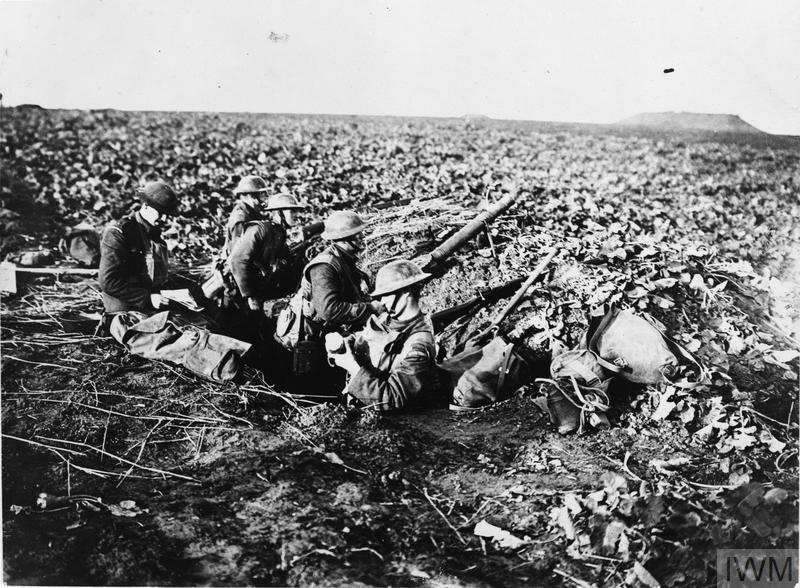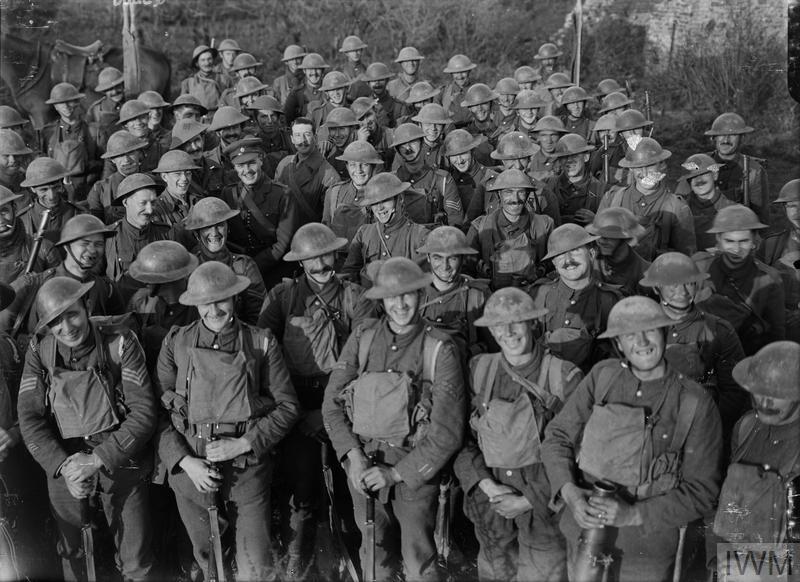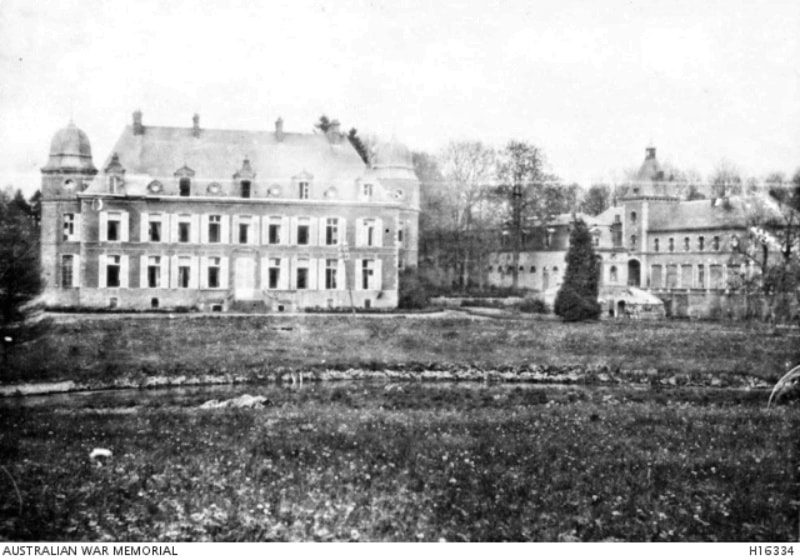DOURLERS COMMUNAL CEMETERY EXTENSION
Nord
France
GPS Coordinates - Latitude: 50.1775, Longitude: 3.94175
Location Information
Doulers (previously Dourlers) is a small village on the D33 off the main road N2 between Maubeuge and Avesnes-sur-Helpe.
The Communal Cemetery Extension, in the Communal Cemetery in the village, will be found by taking the first right turning coming in from the N2.
Visiting Information
Wheelchair access is possible via the main entrance.
Historical Information
Dourlers village was in German hands during almost the whole of the First World War. It was taken on 7 November 1918, after heavy fighting, by the 6th Royal Inniskilling Fusiliers and the 1st K.O.Y.L.I.
The communal cemetery was used by the Germans during the war, but in November 1918, a small extension was made by Commonwealth troops at the west end. After the Armistice, the German graves from the communal cemetery and others from the battlefields, together with Commonwealth graves from isolated positions and the following small cemeteries, were brought into the extension:-
LIMONT-FONTAINE COMMUNAL CEMETERY GERMAN EXTENSION, contained 45 graves;
LANCASHIRE CEMETERY, ST. HILAIRE-SUR-HELPE, contained 15 graves.
The Extension contains 161 Commonwealth burials and commemorations of the First World War. 14 of the burials are unidentified but there are special memorials to four casualties known or believed to be buried among them. The extension also contains 108 German burials, 62 of which are unidentified.
Casualty Details: UK 161, Germany 108, Total Burials: 269
Doulers (previously Dourlers) is a small village on the D33 off the main road N2 between Maubeuge and Avesnes-sur-Helpe.
The Communal Cemetery Extension, in the Communal Cemetery in the village, will be found by taking the first right turning coming in from the N2.
Visiting Information
Wheelchair access is possible via the main entrance.
Historical Information
Dourlers village was in German hands during almost the whole of the First World War. It was taken on 7 November 1918, after heavy fighting, by the 6th Royal Inniskilling Fusiliers and the 1st K.O.Y.L.I.
The communal cemetery was used by the Germans during the war, but in November 1918, a small extension was made by Commonwealth troops at the west end. After the Armistice, the German graves from the communal cemetery and others from the battlefields, together with Commonwealth graves from isolated positions and the following small cemeteries, were brought into the extension:-
LIMONT-FONTAINE COMMUNAL CEMETERY GERMAN EXTENSION, contained 45 graves;
LANCASHIRE CEMETERY, ST. HILAIRE-SUR-HELPE, contained 15 graves.
The Extension contains 161 Commonwealth burials and commemorations of the First World War. 14 of the burials are unidentified but there are special memorials to four casualties known or believed to be buried among them. The extension also contains 108 German burials, 62 of which are unidentified.
Casualty Details: UK 161, Germany 108, Total Burials: 269
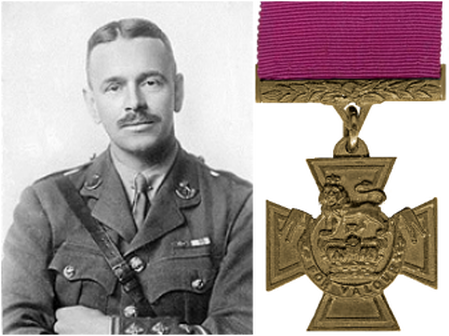
Captain Arthur Moore Lascelles, V. C., M. C.
3rd Bn. Durham Light Infantry, died 7th November 1918 aged 38 years. Plot II. C. 24.
Son of John Lascelles, of Milford Hall, Newtown, Mont.; husband of Sophia Lascelles.
Citation: An extract from "The London Gazette," No. 30471, dated 8th Jan., 1918, records the following:-"For most conspicuous bravery, initiative and devotion to duty when in command of his company in a very exposed position. After a very heavy bombardment during which Capt. Lascelles was wounded, the enemy attacked in strong force but was driven off, success being due in a great degree to the fine example set by this officer, who, refusing to allow his wound to be dressed, continued to encourage his men and organise the defence. Shortly afterwards the enemy again attacked and captured the trench, taking several of his men prisoners. Capt. Lascelles at once jumped on to the parapet and followed by the remainder of his company, 12 men only, rushed across under very heavy machine-gun fire and drove over 60 of the enemy back, thereby saving a most critical situation. He was untiring in reorganising the position, but shortly afterwards the enemy again attacked and captured the trench and Capt. Lascelles, who escaped later. The remarkable determination and gallantry of this officer in the course of operations, during which he received two further wounds, afforded an inspiring example to all."
3rd Bn. Durham Light Infantry, died 7th November 1918 aged 38 years. Plot II. C. 24.
Son of John Lascelles, of Milford Hall, Newtown, Mont.; husband of Sophia Lascelles.
Citation: An extract from "The London Gazette," No. 30471, dated 8th Jan., 1918, records the following:-"For most conspicuous bravery, initiative and devotion to duty when in command of his company in a very exposed position. After a very heavy bombardment during which Capt. Lascelles was wounded, the enemy attacked in strong force but was driven off, success being due in a great degree to the fine example set by this officer, who, refusing to allow his wound to be dressed, continued to encourage his men and organise the defence. Shortly afterwards the enemy again attacked and captured the trench, taking several of his men prisoners. Capt. Lascelles at once jumped on to the parapet and followed by the remainder of his company, 12 men only, rushed across under very heavy machine-gun fire and drove over 60 of the enemy back, thereby saving a most critical situation. He was untiring in reorganising the position, but shortly afterwards the enemy again attacked and captured the trench and Capt. Lascelles, who escaped later. The remarkable determination and gallantry of this officer in the course of operations, during which he received two further wounds, afforded an inspiring example to all."
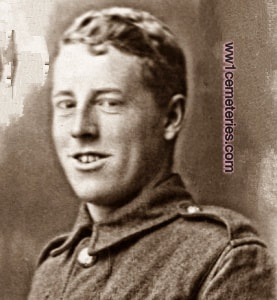
85178 Private
George Jaffray Margerison
18th (Lancashire Hussars) Bn. The King's (Liverpool Regiment)
8th November 1918, aged 19.
Plot II. C. 11.
Son of Fanny Mary Margerison, of Crogga, Port Poderick, Douglas, Isle of Man, and the late Cabel McKune Margerison. Born at Walton-le-Dale, Preston.
Killed in action just 3 days before the Armistice, his parents added the following inscription to his headstone; "Faithful Unto Death."
George Jaffray Margerison
18th (Lancashire Hussars) Bn. The King's (Liverpool Regiment)
8th November 1918, aged 19.
Plot II. C. 11.
Son of Fanny Mary Margerison, of Crogga, Port Poderick, Douglas, Isle of Man, and the late Cabel McKune Margerison. Born at Walton-le-Dale, Preston.
Killed in action just 3 days before the Armistice, his parents added the following inscription to his headstone; "Faithful Unto Death."
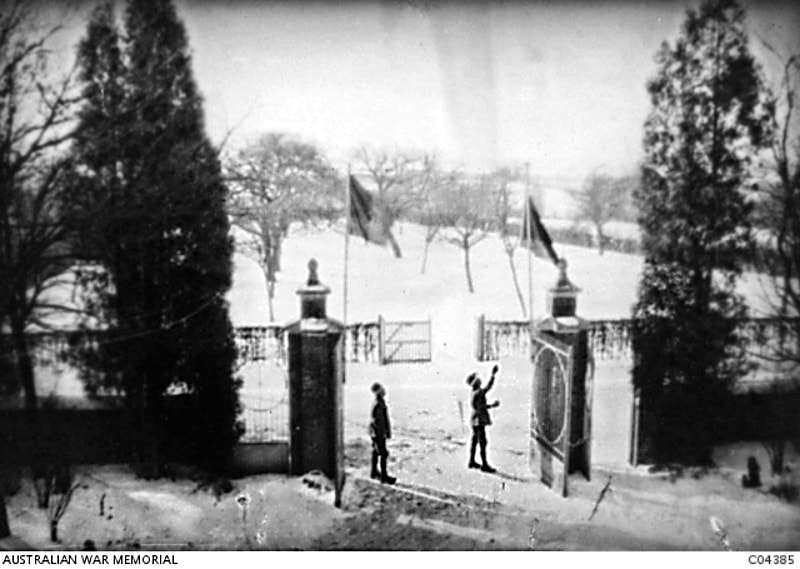
On the 10th February 1919, in consequence of the progress made in demobilisation, the 57th and 58th Battalions were amalgamated under one CO and became known as 57th/58th Battalion. The flags of both battalions which had been presented by the Australian women in London, were flown at the amalgamated battalion's headquarters at Dourlers, France. Regimental Sergeant Major (Warrant Officer) H E Abbott is seen hoisting the flags at the headquarters.

